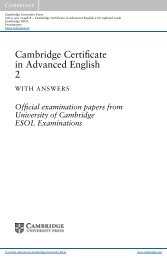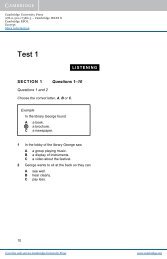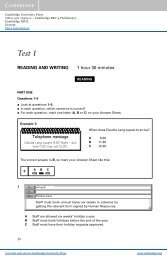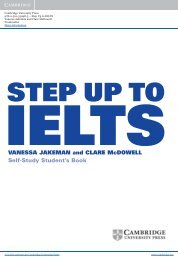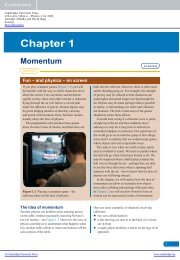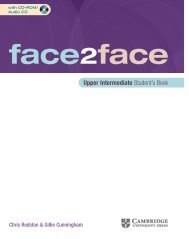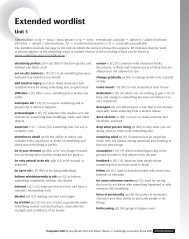Skills for Study Level 2 Teacher's Book - Cambridge University Press
Skills for Study Level 2 Teacher's Book - Cambridge University Press
Skills for Study Level 2 Teacher's Book - Cambridge University Press
You also want an ePaper? Increase the reach of your titles
YUMPU automatically turns print PDFs into web optimized ePapers that Google loves.
them (no particular phrase to avoid, but compare with the more cautious versionbelow), even though other non-brand medicines are just as good. As a result, peoplein poorer countries are unable to get access to the best medicines because they aretoo expensive.bPharmaceutical manufacturing capacity is very restricted. According to the WHO(2004, p.5), over 92% of all new drug development takes place in the so-calledhigh-income countries. The share of drugs manufactured in the poor and middleincomecountries has decreased somewhat in recent years. It seems likely thatthis is because the development of new drugs tends to be a slow and costlyprocess, requiring funding and high technology which is beyond the means of allbut the largest corporations in the wealthy industrialized nations. This apparentconcentration of manufacturing capacity in just a few organizations, however, mayhave serious consequences. Evidence suggests that the drug companies focus ondeveloping only those medicines which they expect to be profitable, and havingmade them they protect them with commercial patents. Medicines manufacturedby the largest pharmaceutical corporations tend to be considerably more expensivethan non-brand medicines, even though these medicines may be equally effective.As a result, it is difficult <strong>for</strong> people in poorer countries to get access to the bestmedicines, at least in part because they are too expensive.Passage 2aEvery two years the World Health Organisation produces a list of essential medicines.These medicines are the ones which the WHO determines are absolutely critical<strong>for</strong> the treatment of all the medical conditions which can be influenced or cured bymedicine. The latest list identifies only 300 to 400 medicines as ‘essential’. However,there are a large number of other medicines which, though effective, may not beessential. Interestingly, a large percentage of the medicines sold in the developingworld by major pharmaceutical firms are not in the WHO’s ‘essential’ category. Thishas contributed to claims that the major pharmaceutical firms tend to ignore ThirdWorld health problems.bEvery two years the World Health Organisation produces a list of essential medicines.These medicines are the ones which are absolutely critical <strong>for</strong> the treatment of allthe medical conditions which can be influenced or cured by medicine. The latestlist proves that only 300 to 400 medicines are ‘essential’. However, there are many,many more medicines which, though effective, are not essential. Interestingly, a lotof the medicines sold in the developing world by major pharmaceutical firms arenon-essential. This shows that major pharmaceutical corporations ignore Third Worldhealth problems.Passage 3aOne study by the WHO shows that 50% of all medicines in low- and middle-incomenations are used inappropriately. The reasons <strong>for</strong> this are: improper advertising ofdrugs directly to consumers, creating demand <strong>for</strong> drugs among patients; lack oftraining <strong>for</strong> doctors and nurses; and commercial pressure from pharmaceuticalcompanies. Another reason is lack of access to critical in<strong>for</strong>mation about the dosageand use of the drugs.Unit 3 Part C ∙ Investigating 93



